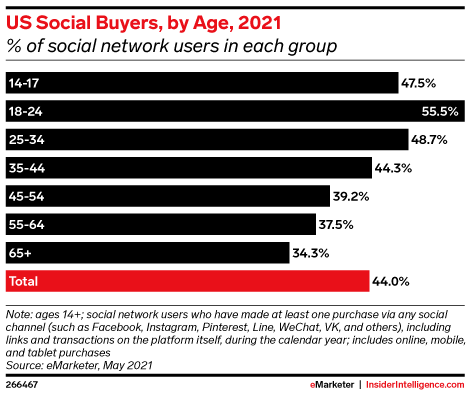How Social Commerce Is Evolving and Impacting Retail

What is social commerce?
Social commerce is the marketing, selling, and purchasing of products directly through social media platforms. Social commerce in China has become a retail powerhouse — generating $400 billion in sales in 2021 and is expected to become a mainstay for global online shopping, forecasted to hit $1.2 trillion in revenue by 2025, reports Accenture. In the US, it’s predicted to reach $80 billion by 2025.
Social commerce combines the experience of social media, connection, and shopping all within the favorite apps that shoppers spend significant time on each day. This streamlines the shopping experience right from the convenience of the user’s device without having to click away in the buying process. It is a powerful trend within e-commerce and retail — one that e-commerce retailers need to participate in to stay relevant.
E-commerce vs social commerce
Traditional e-commerce happens on a brand’s website or app, often after a shopper clicks a social ad. Social commerce, by contrast, takes place entirely within social media—through live streams, influencer posts, or in-app buy buttons.
Who partakes in social shopping?

Social shopping is especially popular with Gen Z—over half of U.S. users aged 18–24 have bought through social platforms. But it’s not just them; 44% of users aged 14 to 65+ have too. It’s convenient, trusted, and keeps shoppers in the app.
Alongside big brands, social commerce thrives with small businesses offering personal service and building tight-knit communities. Shoppers discover unique products, and viral posts can quickly reach millions.
Why is social commerce appealing?
Social commerce engages customers through individuals, influencers, and brands. It’s popularity tends to be driven by:
- Engaging content. User generated content (UGC) and brand generated content inspire potential customers by providing interesting, relevant information and opinions that often feature videos of products in real life. Shoppable posts and in-app stores on major social platforms make it easy for social media users to choose to buy right then and there.
- Experiences that feel inclusive. Livestreaming lets users join real-time, limited-time shopping events, while AR/VR tools let them try products virtually. Social buyers love experiences that make them feel valued and connected to the brand.
- Micro-influencers.Beyond big influencers, micro-influencers (under 10k followers) often drive social commerce. They’re more trusted, cost less, and connect brands with niche, highly targeted audiences.
Social media with social commerce platforms
Outside of China’s social platforms, four major social media platforms offer native social commerce functionality:
- Facebook. Facebook leads in social commerce, with 71% of global users shopping on the platform. Brands set up a Business account, create a Shop and Page, showcase products, chat via Messenger, and sell directly through Facebook Checkout.
- Instagram. The platform reports that 44% of people buy products on Instagram weekly. Business account holders set up Instagram Shops to showcase products with images, videos, and livestreaming.
- TikTok. This newer-to-the-US social platform reports that 39% of users have found a product they weren’t aware of before and nearly half have made a purchase. Brands create a TikTok for Business account, add shopping tabs to their profile, and use a virtual storefront to engage shoppers.
- Pinterest. This social media platform is image based. More than 400 million people per month create mood boards, pin their favorite images into categories of their interest, and use it for product discovery. Social commerce retailers can upload images of their products to Pinterest to expand their reach.
Other social networks, like Snapchat, have or are developing a social commerce strategy to take part in this growing movement.

Top 7 benefits of social commerce
Adding social commerce to an e-commerce retail strategy has multiple benefits:
- Drives customer experiences where customers are already spending time.
- Delivers a frictionless online shopping experience.
- Enables a more personalized engagement with customers.
- Empowers businesses to reach larger or more targeted audiences.
- Facilitates direct customer feedback and data gathering.
- Expands e-commerce sales and revenue streams.
- Creates a way for brands to introduce new products, expand brand awareness, and enter or test new markets.
How retail brands can engage in social commerce
With social commerce becoming a dominant force in e-commerce, retailers need to develop a social commerce strategy that will harness the power of this new channel. Social selling is expected to become a mainstay in online shopping, and no doubt will become part of a blended, omnichannel experience.
Here are ways retailers can engage in social commerce:
- Deploy a social commerce platform within existing social media channels
- Create an influencer marketing campaign that includes micro-influencers
- Curate unique experiences on social with options to buy products during those experiences
- Ensure the purchase process in the social platform is frictionless
- Develop UGC and video content that showcases products in real life, instructions, and ideas on how to use products in creative ways
- Partner with other brands to feature unique offers and sales
- Dedicate a customer care team to be responsive to social commerce interactions

Social commerce is shaping retail in new ways. To be successful at social commerce, brands need a fast, accurate, and convenient order fulfillment process. This may include traditional fulfillment or dropshipping that makes sure that customers that buy within social platforms have a smooth checkout, order processing, fulfillment, delivery, and returns experience.
Radial offers brands the support they need for social commerce experiences by providing order fulfillment solutions that focus on an exceptional customer experience.
Contact Us (EUR)
By submitting this form, you agree to our friendly privacy policy.
